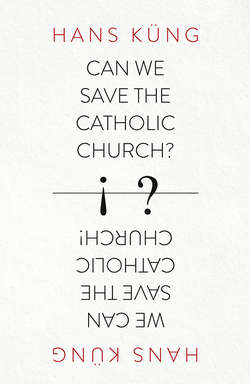Читать книгу Can We Save the Catholic Church? - Hans Kung - Страница 8
The Cause of the Illness
ОглавлениеTo begin, let me make one thing clear: I am an ecumenical theologian concerned with the Church in all its manifestations, and I am by no means fixated exclusively on the figure of the pope. In my book Christianity: Its Essence and History (1995), I devoted over 1,000 pages to a description and analysis of the history of Christianity as a whole. But it cannot be denied that the papacy is the central element of the Roman Catholic paradigm, and it is the papacy and its power that is primarily and urgently in need of reform.
The papacy as it took shape in the Christian Church of the first centuries, i.e. as a ministry in succession to St Peter, was and remains to this day a meaningful institution for many Christians, not just Roman Catholics. But, from the eleventh century onwards, this institution gradually morphed into the monarchical–absolutist papacy that has dominated the history of the Roman Catholic Church ever since. It is this monarchical–absolutist papacy that has been responsible for the three great schisms mentioned above. Ever since the Middle Ages, the growing power of the papacy within the Catholic Church, notwithstanding numerous political setbacks and cultural defeats, has become the crux of the Roman Catholic Church’s history. Thus, Catholicism’s contemporary neuralgia is not a problem of liturgy, theology, lay piety, monastic rules or art, but rather a problem linked to the very constitution of the Roman Catholic Church. In traditional histories of the Catholic Church, however, far too little critical attention has been given to the problems generated by how the papacy has developed. For this reason, I will examine these problems with special care in the present book, not least because of their explosive ecumenical significance, for their consequences are not confined to the Roman Catholic Church alone; they also affect the other Christian denominations, the dialogue with other religions and ideologies, and the relationship of the Catholic Church to the modern world as a whole.
Fifty years ago, Joseph Ratzinger and I were the two youngest official advisors to the Second Vatican Council (1962–5). That Council tried to reform important elements of the Roman system, but, unfortunately, the stubborn resistance of the Roman Curia managed by and large to hamper these efforts and to restrict their success. In the decades since the Council, Rome has gradually been turning back the clock on the proposals for reform and renewal, and this has in turn led to a renewed outbreak of an already rampant and alarming disease in the Catholic Church. The sexual abuse scandals caused by Catholic clergymen are only the latest symptom. The objections to these scandals have become so vehement that, in any other large organization, they would have triggered an intensive investigation into the reasons behind such a tragedy. Not so, however, for the Roman Curia or the Catholic episcopate! At first, Rome and the episcopate simply denied any share in the responsibility for the systematic cover-up of these cases. And, when that strategy failed, they have, with very few exceptions, shown little interest in uncovering the deep historical and systemic reasons for such horrific aberrations.
The regrettable refusal to look at the causes of this sickness compels me to bring out into the open the historical truth about the Christian Church, starting from its origins – in the face of all the current attempts to forget, conceal and cover them up. For people with little detailed historical education, for traditional Catholic readers, and possibly even for some bishops, these facts will undoubtedly prove frightening and disillusioning. Someone who has never been seriously confronted with historical facts of this kind will certainly be dismayed to learn how things have been done over long periods of time and how all too human so many Church institutions and constitutions – particularly the core Roman Catholic institution of the papacy – are.
However, there is also a positive side to these disappointing and disillusioning facts: they show that the Church’s institutions and its character – beginning with the papacy – can in fact be changed, even fundamentally reformed. The papacy need not be abolished, but it should be renewed in such a way that the Petrine ministry once again becomes the office in the succession to St Peter described in the Bible. However, what does need to be abolished is the Medieval Roman system of governance and control. My critical destruction is therefore done in the service of committed construction, of reform and renewal, in the hope that, despite all appearances to the contrary, the Catholic Church will remain viable into the third millennium.
